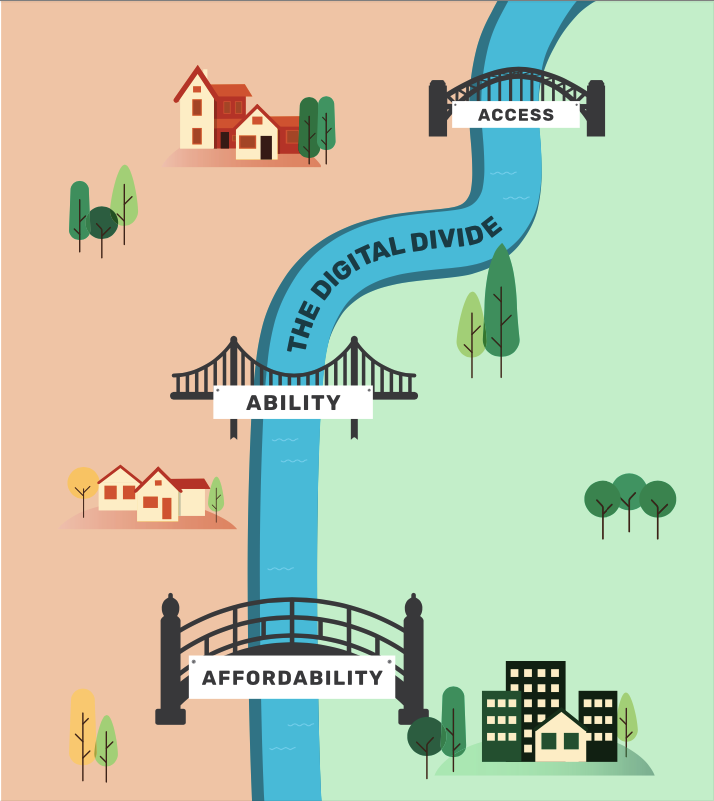Have you had one of the 50 million [1] telehealth consultations held during the pandemic?
Whether looking up health information online, accessing e-prescriptions, using mindfulness apps, or taking advantage of telehealth, navigating the Australian health system today increasingly relies on digital technology. This has accelerated since COVID-19, where healthcare, like many other services, rapidly moved online due to lockdowns amid risks for vulnerable patients.
However, there is a significant risk in the digitisation of healthcare that some will be unable to fully access it at the exact time when they need it most.

The digital divide in Australia means that some people do not have the affordable access or skills and confidence to use the internet safely.[2] The populations most affected by the digital divide are the same populations experiencing higher rates of chronic disease, and already worse healthcare outcomes. People from the lowest socioeconomic groups – people on low incomes, that are unemployed, that have low levels of education – are more likely to have higher rates of illness and chronic disease such as diabetes, are more likely to suffer heart stroke and vascular disease, have chronic kidney disease, have a disability and live shorter lives compared to people from higher socioeconomic areas.[3]
That’s why at Good Things Foundation, we are no longer just talking about the ‘digital divide’ but now also the ‘digital health divide’.
Importantly, the digital health divide is unlikely to be confined only to the people in the lowest socioeconomic areas. According to the 2021 Australian Digital Inclusion Index, 1 in 4 Australians are considered digitally excluded.[4] Less than half of all Australians believe that computers and technology give them more control over their lives and less than 40% feel they can keep up with the changing technological landscape.[5]
Practically, we have seen this present itself in patients not being able to afford the data to wait on the line for a video call with their doctor to begin. Regional communities are not able to participate in consultations with city specialists from home due to poor connectivity. Parents are making the difficult decision between affording the data for a telehealth appointment or their child’s virtual school lesson.
Many do not know how to find reliable, trustworthy health information online or that helpful health and wellbeing apps even exist
There may also be longer term disadvantages created by the inability of some to access quality health information or use technology to better manage their health conditions and improve their general wellbeing, compared to those that can.
The challenge, therefore, with the increasing adoption of digital technology in healthcare is to avoid widening the digital health divide into a chasm, and further exacerbating health inequity for our vulnerable populations.
While there is broad acknowledgement that digital health technology has great potential to benefit the lives of Australians, specific effort is needed to ensure that it benefits all Australians. We must make sure that everyone, and particularly already vulnerable populations, are not further disadvantaged through poor digital access and low digital confidence and skills.
As the leading organisation in digital literacy both in Australia and the UK, Good Things Foundation has spearheaded broadscale initiatives to support digital health literacy for consumers. Building on the success of our essential digital skills for life program Be Connected, through which we have reached more than 1 million people, in 2019-21 we delivered Health My Way – a national digital health literacy program. This program established local support through community partners in 75 locations across Australia, helping people to better understand and use digital technology for the benefit of their health and wellness.
Through this program, we created the concept of a “Digital Health Mentor” – the community-based ‘guide on the side’ who helps people to understand the benefits of digital health, become motivated to learn more about how it could help them, and gain the skills to practically use it in their lives.
The evaluation of Health My Way demonstrated both the need for and value of having this local learning and support approach for digital health literacy provided through a diverse range of trusted community organisations already supporting communities in different ways. It also showed that these Digital Health Mentors needed our help to themselves understand how to effectively deliver this support, how to refer to trustworthy sources of information and use digital health tools. And, just as importantly, when to advise people not to use the internet for health advice.
We are now also working in partnership with Consumers Health Forum on further expanding the concept of the Digital Health Mentor into a “Digital Health Navigator” for the Australian context. Already trialled in Denmark, Digital Health Navigators would provide a bridge to ensure health professionals and patients can connect rapidly with each other at any virtual consultation. The Navigator would direct patients to the information and digital tools they require to assist them to better manage their health conditions at home and local communities. This would support the vital work of healthcare professionals, enabling them to focus on doing what they do best – supporting the health of their communities.
We are now also working in partnership with Consumers Health Forum on further expanding the concept of the Digital Health Mentor into a “Digital Health Navigator” for the Australian context.
From speaking with government, healthcare professionals, community workers and patients, it is clear that the increasing focus on telehealth and virtual care delivery by health services necessitates more than ever before a national, coordinated approach to digital inclusion. To support our communities’ to navigate the health system in the 21st century, this approach must include everyone in Australia having equal and reliable digital access, an affordable connection and the ability to use it confidently and safely. Our submission to the National Digital Health Strategy refresh recommended just that.
We also called for ongoing targeted and funded health-specific digital inclusion initiatives to realise the full potential of digital health in Australia, and for community education programs, like Health My Way, to be extended so all Australians have the skills to adopt telehealth and digital health initiatives and find reliable health information online. In an election year, when worthy causes will jostle to be prioritised, we would argue there is little more important than ensuring no one is left behind – unable to participate in our digital world and equally access all the benefits that digital health has to offer.
About the Author
 Liz Jones is Good Things Foundation Australia’s Director of Partnerships & Growth. Liz has 20 years’ experience working across health, government, community/not for profit and commercial sectors. For more than 10 years Liz held senior roles delivering national digital health programs to improve health outcomes for Australians. Most notably Liz led the engagement for consumer engagement, communications and education to support the expansion of the My Health Record system in 2018/19 to all Australians. Liz joined the Good Things Foundation Australia leadership team in 2020.
Liz Jones is Good Things Foundation Australia’s Director of Partnerships & Growth. Liz has 20 years’ experience working across health, government, community/not for profit and commercial sectors. For more than 10 years Liz held senior roles delivering national digital health programs to improve health outcomes for Australians. Most notably Liz led the engagement for consumer engagement, communications and education to support the expansion of the My Health Record system in 2018/19 to all Australians. Liz joined the Good Things Foundation Australia leadership team in 2020.
References
[1] Snoswell, C.L., Caffery, L.J., Taylor, M.L., Haydon, H.M., Thomas, E., Smith, A.C. Centre for Online Health, The University of Queensland. Telehealth and coronavirus: Medicare Benefits Schedule (MBS) activity in Australia. https://coh.centre.uq.edu.au/telehealth-and-coronavirus-medicare-benefits-schedule-mbs-activity-australia. Accessed 28 February 2022.
[2] Thomas, J., Barraket, J., Parkinson, S., Wilson, C., Holcombe-James, I., Kennedy, J., Mannell, K., Brydon, A. (2021). Australian Digital Inclusion Index: 2021. Melbourne: RMIT, Swinburne University of Technology, and Telstra, p 4.
[3] Australian Institute of Health and Welfare, https://www.aihw.gov.au/reports/australias-health/health-across-socioeconomic-groups. Accessed 23 July 2020
[4] Thomas et al (2021), p 5.
[5] Thomas, J, Barraket, J, Wilson, CK, Holcombe-James, I, Kennedy, J, Rennie, E, Ewing, S, MacDonald, T, (2020), Measuring Australia’s Digital Divide: The Australian Digital Inclusion Index 2020,RMIT and Swinburne University of Technology, Melbourne, for Telstra, p 15.
